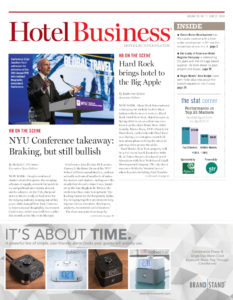NEW YORK—As the planned acquisition of Starwood Hotels & Resorts Worldwide Inc. this year by Marriott International proceeds apace, so, too, do the plans of two Starwood global brand leaders to continue expanding distribution of their respective products.
Hoyt Harper and Jim Petrus, who lead The Luxury Collection Hotels & Resorts and St. Regis Hotels & Resorts, respectively, were recently here in Manhattan to give an update on properties coming on line, as well as what’s in the posh brands’ pipelines.
Petrus acknowledged there was a bit of a limbo-like atmosphere pending the Marriott deal’s anticipated close, which is expected in July.
One question he addressed was: What happens with the integrity of these assets (e.g., St. Regis), and how do things move forward?
“I think it would be safe to assume [Marriott] bought these great assets because of what they are, and it only makes logical sense that they maintain the integrity of what they represent,” said Petrus. “We’re proud of the brands we have, we’re proud of the assets that we have and we’re going to work closely with Marriott to make sure that things remain intact to the best of our ability.”
He added contemporary travelers are all about “the experience,” which both St. Regis and The Luxury Collection are programmed to deliver as a matter of course.
Following the recent opening of The St. Regis Dubai, last month in Malaysia the brand debuted the St. Regis Kuala Lumpur, which was developed and is owned by ONE IFC Sdn Bhd as part of a mixed-use development in the city’s Sentral Precinct.
“The owner there has one objective, one ambition: to create uniqueness,” said Petrus, noting the 208-key property is rife with art that includes works by Fernando Botero, Mark Evans and Barnaby Hosking. It also features a wedding/event space with an LED video wall that runs the circumference of the Grand Ballroom.
According to Carmen Chua, CEO of ONE IFC Sdn Bhd, the company’s collaboration with St. Regis “further positions Kuala Lumpur as a global city, redefining luxury hospitality in Malaysia and the region.”
Only a month earlier the St. Regis brand had debuted in Malaysia with the opening of the St. Regis Langkawi, which is owned by Integrated Nautical Resort Sdn Bhd, a joint venture between Rajawali Group and the Government of Malaysia’s Ministry of Finance.
The all-suites luxury resort offers four private overwater villas and 85 suites, each of which has a distinct design.
The hotel also features six restaurant and bar venues, including Kayuputi, which includes an antique collection featuring century-old wooden doors and windows repurposed from the Dutch embassy in Yangon and 60 teak columns inlaid with camel bone from India.
St Regis plans to add three more locations this year, including in the Maldives and Changsha, China.
“In September in the Maldives [will be]a 77-room hotel, all villas [over]water, designed by the architectural firm out of Singapore called Wow. And how appropriate because this property will be an absolute wow from an experiential standpoint,” said Petrus. Among its features are five restaurants, one of which is a pop-up housed in a cargo container that will highlight a rotating menu of ethnic cuisine. “It’s an element of surprise and an element of excitement,” noted Petrus.
The property, located on a private island, will be reachable via seaplane from Bali.
“We are absolutely thrilled about where the brand is going; again, very selective growth,” said Petrus, noting an additional 18 properties are slated to join the portfolio over the next four years, including in destinations such as Shanghai, Hong Kong, Cairo, Jakarta, Bermuda and Riviera Maya.
Harper said The Luxury Collection in 2015 had its strongest growth year in 20 years. “We opened 11 properties, ranging from Bodrum in Turkey to Milan to the Augustine in Prague to the St. Anthony in San Antonio,” he said.
“Our growth came from two areas,” Harper told Hotel Business. “One, continued expansion in Asia with new-build opportunities, and significant growth from existing, independent luxury hotels that want the security and the efficiency of a global brand.
“We had a banner year, achieving our one hundredth property—the Augustine in Prague,” added Harper. “It was part of an affiliation program and joined our brand in September. We’re seeing many other independent, luxury hotels inquire and many plan to join us in the near future.”
The executive noted within Starwood—and something he expects to be retained under Marriott—there are dedicated, luxury service centers, sales teams to support elite travel agent programs, segmentation within the SPG loyalty program for guests who stay in the luxury brands, and luxury partnerships, such as with auto makers Bentley and Maserati, and Moët Hennessy.
“Segmentation within the company and being able to offer value to an owner and more-efficient central delivery is what’s attracting these independent, luxury hotels to us,” said Harper.
Additionally, the brand renovated landmark properties all over the world and, this year, is continuing in that effort.

A Luxury Collection Hotel in Boston recently completed an $11-million guestroom renovation.
Photo: Dom Miguel
For example, the brand in the spring completed an $11-million guestroom and suite renovation with interior designer Bill Rooney of the 298-key The Liberty, a Luxury Collection Hotel, Boston, which is an adaptive-reuse of the Charles St. jail in Beacon Hill. The project is considered a cornerstone in the brand’s $300-million investment effort to renovate and reopen iconic hotels in North America.
“We’re a brand that really defines experiential luxury,” said Harper. “We look for hotels that are authentically indigenous and provide memorable experiences.
The Luxury Collection currently has plans to open hotels in Vail, CO; St. Helena and North Lake Tahoe, CA; China; Tokyo; and Cuba, the first U.S.-based hotel company to re-enter the island nation after more than a half-century. “The hotels were selected with great care,” noted Harper.
For example, The Prince Gallery Tokyo Kioicho will become part of The Luxury Collection in July. Owned by Prince Hotels, Inc., the hotel will be the Collection’s second property in Japan, following the opening of Suiran in Kyoto in April 2015.
The hotel is part of Tokyo Garden Terrace, a mixed-use development tower that will encompass retail, offices and residences. The 250-key hotel, designed by Rockwell Group Europe, will be located on the 30th to 36th floors and will include a lobby on the top floor with city views. The 35th floor will feature a signature bar with views of the cityscape.
According to Shigeyoshi Akasaka, president of Prince Hotel, Inc., “The demand for luxury hospitality continues to be on the rise in Japan, especially as Tokyo prepares to host the 2020 Summer Olympic Games and the Paralympics.”
With 38 hotels (at press time) in the St. Regis portfolio and close to two dozen in the pipeline, Petrus felt the brand does resonate with owners, developers and guests in “all corners” of the globe.
“What’s interesting is the bulk of our growth is predominantly in Asia-Pacific and Europe. What was once a New York-centric brand [the original St. Regis still operates on Manhattan’s Fifth Ave.]has had great success in being able to spread its antennas,” said Petrus.
On the consumer side, he added, the brand resonates with different demographics. “Thirty-two percent of our customers are under the age of 32…a lot of people would think the St. Regis brand is attractive to an older clientele. This is very encouraging for developers because they look at this as having a longer life span with that customer, who is, in many cases, is an aspirational customer,” said Petrus.
“Our strategy is we want to grow selectively and strategically in global, gateway cities and in unique resort destination markets around the world,” Petrus said.
Luxury hotels often are thought able to be supported in only certain destinations and Petrus felt part of the challenge “is really to find the emerging markets that can support a luxury property. When you look at the Maldives, for example, in 1972 there were two resorts; today, there are 102. So that’s a destination that someone, at one time, discovered and that people find appealing. And with a generation of travelers who are explorers, they want new, exciting destinations. I think the luxury hotel company of the future will be the one that finds those destinations sprinkled around the world that have accessibility and a sense of uniqueness and exploration.”
Which is, potentially, what Cuba will offer for Luxury Collection guests in the future. In March, Starwood became the first hospitality company to obtain U.S. Treasury Department authorization to operate in Cuba. The chain has inked agreements and a Letter of Intent to open hotels in Havana this year. Starwood partnered with owner Gran Caribe to rebrand the 1875 Hotel Inglaterra, which will join The Luxury Collection, and Hotel Santa Isabel, owned by Habaguanex, is expected to be converted to a TLC hotel. [Also, the Hotel Quinta Avenida will become a Four Points by Sheraton].
“We’ve been selective in identifying properties we believe, upon renovation, will be truly iconic…and define authentic, indigenous luxury,” said Harper. HB


